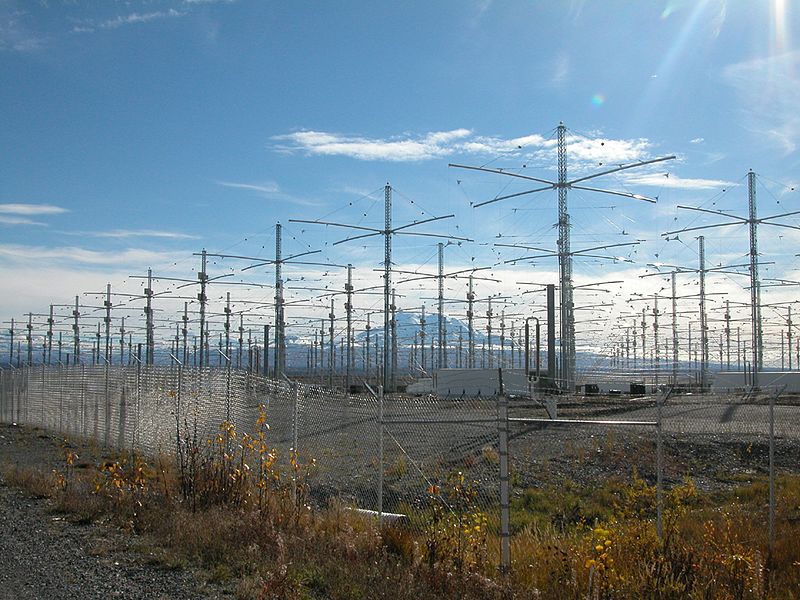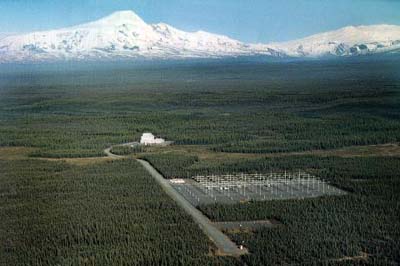
The High Frequency Active Auroral Research Program (HAARP) is an ionospheric research program jointly funded by the U.S. Air Force, the U.S. Navy, the University of Alaska, and the Defense Advanced Research Projects Agency (DARPA).Built by BAE Advanced Technologies (BAEAT), its purpose is to analyze the ionosphere and investigate the potential for developing ionospheric enhancement technology for radio communications and surveillance. The HAARP program operates a major sub-arctic facility, named the HAARP Research Station, on an Air Force—owned site near Gakona, Alaska.This thrust of the 2013 program, budgeted at $11 million, will obtain insights into physical aspects of natural phenomena such as magnetospheric sub-storms, fire, lightning, and geo-physical phenomena. New fundamental understandings of these phenomena will enable the ability to predict and exploit these physical processes, especially with regard to communications. Last year’s HAARP budget was $13 million and the 2011 was about $9 million.
A major emphasis of this thrust is to provide predictive models for the interactions between plasmas and electromagnetic waves across a range of energy and length scales, and into new regimes.
Upper-atmospheric lightning or upper-atmospheric discharge are terms sometimes used by researchers to refer to a family of short-lived electrical-breakdown phenomena that occur well above the altitudes of normal lightning and storm clouds. Upper-atmospheric lightning is believed to be electrically induced forms of optical fluorescence. The preferred usage is transient luminous event, because the various types of electrical-discharge phenomena in the upper atmosphere lack several characteristics of the more familiar tropospheric lightning. TLEs include red sprites, sprite halos, blue jets, gigantic jets, and ELVES
Representation of upper-atmospheric lightning and electrical-discharge phenomena

HAARP has been blamed by conspiracy theorists for a range of events, including numerous natural disasters. Various scientists have commented that HAARP is an attractive target for conspiracy theorists because according to computer scientist David Naiditch, “its purpose seems deeply mysterious to the scientifically uninformed”. The program will also study the critical factors affecting magnetospheric sub-storms; the generation and amplification of extremely low frequency (ELF)/ultra low frequency (ULF)/very low frequency (VLF) radiation in the ionosphere utilizing the High Frequency Active Aural ResearchProgram (HAARP) transmitter; and understanding and quantifying the interaction of electromagnetic and acoustic waves with the plasma in flames.FY2010 Accomplishments:- Initiated a series of HAARP experimental campaigns to study ionospheric and trans-ionospheric phenomena, including: optimization of high frequency to very low frequency conversion efficiency, wave-particle interaction, generation and propagation of ultra low frequencies, very low frequencies and artificial ducts, triggering and characterization of specific ionospheric instabilities.- Developed theoretical models for triggered lightning, transient luminous events, lightning-induced electron precipitation and related ionospheric phenomena.- Developed theoretical models for lightning initiation, propagation, and attachment.FY 2011 Accomplishments:
The program will also study the critical factors affecting magnetospheric sub-storms; the generation and amplification of extremely low frequency (ELF)/ultra low frequency (ULF)/very low frequency (VLF) radiation in the ionosphere utilizing the High Frequency Active Aural ResearchProgram (HAARP) transmitter; and understanding and quantifying the interaction of electromagnetic and acoustic waves with the plasma in flames.FY2010 Accomplishments:- Initiated a series of HAARP experimental campaigns to study ionospheric and trans-ionospheric phenomena, including: optimization of high frequency to very low frequency conversion efficiency, wave-particle interaction, generation and propagation of ultra low frequencies, very low frequencies and artificial ducts, triggering and characterization of specific ionospheric instabilities.- Developed theoretical models for triggered lightning, transient luminous events, lightning-induced electron precipitation and related ionospheric phenomena.- Developed theoretical models for lightning initiation, propagation, and attachment.FY 2011 Accomplishments:
– Investigated unexpected, GPS-derived total electron enhancements (25 percent larger than previously observed) and overshoots and the mechanisms behind these phenomena, which may provide significant insight into artificial ionization caused by descending plasma plumes.
– Conducted a comprehensive series of ELF/ULF/VLF generation experiments and accomplished first ever generation of ELF waves (10-50 Hz) without the presence of a Polar Auroral electrojet using the ionospheric current drive (ICD).
– Characterized ionospheric current drive (ICD), artificially stimulated emissions in the ionosphere, and ionospheric turbulence and associated scintillations.
– Developed and implemented a continuously-operational, comprehensive array of instruments that measure emissions generated by tropospheric lightning, the associated electric and magnetic fields, and the appropriate time derivatives of these fields which indicate how rapidly they change.
– Discovered potential correlation between compact intracloud discharges (CIDs) and gigantic blue jets (leaders that extend up to 35 km in altitude).
– Deployed balloons into thunderstorms to make in-situ electric field, X-ray and gamma-ray measurements.
– Characterize conditions surrounding artificial duct creation and conduct experiments to determine mechanisms by which VLF waves can be injected into these ducts.
– Conduct a series of experiments to quantify D-region absorption, F-region irregularities, spatial distribution of ELF/VLF source currents, and Electrojet electric fields.
– Conduct a series of experiments to optimize the efficiency of ULF generation and potentially gain active control of their lateral propagation paths and injection into the magnetosphere.
– Conduct comprehensive research campaigns using both triggered and natural lightning during the fall/winter storm seasons to measure all atmospheric, electromagnetic and ionospheric phenomena associated with positively-charged-winter-time lightning.
– Conduct comprehensive fall/winter research campaigns to study the initiation of transient luminous events, early VLF events, and lightning-induced electron precipitation events by providing the known event timing, location, and properties inherent to rocket-triggered lightning.
FY 2012 Plans:
– Conduct comprehensive HAARP-ULF experiments to study the onset of noise under a variety of space-weather conditions.
– Conduct a series of experiments to inject VLF waves into artificial ducts.
– Develop, implement and test a continuously-operational, extensive array of instruments which will measure all atmospheric and electromagnetic components of tropospheric lightning and correlate this phenomenon with various ionospheric events.
– Deploy balloons into thunderstorms to make in-situ electric field, X-ray and gamma-ray measurements.
– Develop and deploy a constellation of receivers to study the radio emissions generated by lightning and associated ionospheric events.

FY 2013 Plans:
– Conduct numerical studies of ion dynamics caused by ULF, and of VLF wave propagation through the ionosphere inside density ducts created by artificial heating.
– Experimentally attempt 3-D observations of HF-induced plasma structures and potentially determine relative HF power absorption for different altitudes, frequencies and geophysical conditions.
– Experimentally quantify the impact of triggered lightning on properties of natural lightning (including the emission of gamma rays, X-rays, UV, VNIR/SWIR, RF,VLF/ULF) and on the properties of ionospheric phenomena (elves, sprites, whistlers, etc.).
– Experimentally quantify the impact of tropospheric lightning (both triggered and natural) and its ionospheric components on the conductivity of the ionosphere and the resultant scattering of sub-ionospherically-propagating VLF signals.
– Experimentally quantify the impact of CIDs on lightning propagation as well as their potential contribution to the production of very large blue jets.
Blue jets differ from sprites in that they project from the top of the cumulonimbus above a thunderstorm, typically in a narrow cone, to the lowest levels of the ionosphere 40 to 50 km (25 to 30 miles) above the earth. In addition, whereas red sprites tend to be associated with significant lightning strikes, blue jets do not appear to be directly triggered by lightning (they do, however, appear to relate to strong hail activity in thunderstorms).


You must be logged in to post a comment.